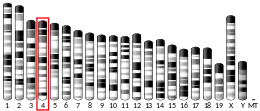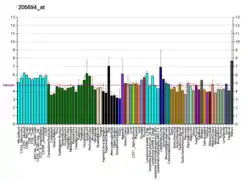| TYRP1 | |||||||||||||||||||||||||||||||||||||||||||||||||||
|---|---|---|---|---|---|---|---|---|---|---|---|---|---|---|---|---|---|---|---|---|---|---|---|---|---|---|---|---|---|---|---|---|---|---|---|---|---|---|---|---|---|---|---|---|---|---|---|---|---|---|---|
| Identifiers | |||||||||||||||||||||||||||||||||||||||||||||||||||
| Aliases | TYRP1, CAS2, CATB, GP75, OCA3, TRP, TRP1, TYRP, b-PROTEIN, tyrosinase related protein 1 | ||||||||||||||||||||||||||||||||||||||||||||||||||
| External IDs | OMIM: 115501 MGI: 98881 HomoloGene: 464 GeneCards: TYRP1 | ||||||||||||||||||||||||||||||||||||||||||||||||||
| |||||||||||||||||||||||||||||||||||||||||||||||||||
| |||||||||||||||||||||||||||||||||||||||||||||||||||
| |||||||||||||||||||||||||||||||||||||||||||||||||||
| |||||||||||||||||||||||||||||||||||||||||||||||||||
| |||||||||||||||||||||||||||||||||||||||||||||||||||
| Wikidata | |||||||||||||||||||||||||||||||||||||||||||||||||||
| |||||||||||||||||||||||||||||||||||||||||||||||||||
Tyrosinase-related protein 1, also known as TYRP1, is an intermembrane enzyme which in humans is encoded by the TYRP1 gene.[5][6]
Function
Tyrp1 is a melanocyte-specific gene product involved in melanin synthesis within melanosomes.[7] Most Tyrp1 possess 5,6-dihydroxyindole-2-carboxylic acid (melanogenic intermediate) oxidase activity.[8] The catalytic function of Tyrp1 in human melanocytes is less clear. Tyrp1 is involved in stabilizing of tyrosinase protein and modulating its catalytic activity.[7] Tyrp1 is also involved in maintenance of melanosome structure and affects melanocyte proliferation and melanocyte cell death.[9] Melanocytes are derived from the neural crest and migrate into the overlying epidermal ectoderm of a developing organism which forms skin and hair.[10] Therefore, Tyrp1 influences the expression of melanin notably in the skin and hair of an organism.
The Tyrp1 gene also has a non-coding function which indirectly promotes melanoma tumor cell proliferation, especially when highly expressed in a cell.[11] Tyrp1 mRNA interacts with miR-16 and affects its ability to repress genes involved in melanoma cell production.[11]
Clinical significance
Mutations in the mouse Tyrp1 gene are associated with brown pelage and in the human TYRP1 gene with oculocutaneous albinism type 3 (OCA3).[9] An allele of TYRP1 common in Solomon Islanders results in blond hair. Although the phenotype is similar to Northern European blond hair, this allele is not found in Europeans.[12][13] More recent study, Ju et al. 2020 found TYRP1 allele was selected in European population.[14]
Norton et al. 2016 study found TYRP1 is not associated with blond hair color in Melanesians as many populations in Oceania did not carry TYRP1 alleles but still displayed blondism, study indicates that additional unknown alleles contribute to the blondism phenotype in Melanesians.[15]
Alterations of the Tyrp1 gene is responsible for some of the differing phenotypes of skin and coat appearance in various animals. In Dalmatians, black versus "liver" spot color is due to genetic variation of the TYRP1 gene.[16] A particular deletion in the Tyrp1 gene of domestic Chinese-Tibetan swine results in a "brown coloration" of the swine's skin and hair as opposed to the wild-type "black" phenotype.[17] In Oujiang-color carp, mutations of the Tyrp1 gene influenced the expression of "grey" or "brown" phenotypic color of scales.[18]
Elevated levels of Tyrp1 gene expression is also associated with unfavorable patient outcome of those affected by melanoma.[11] The role of Tyrp1 in melanoma progression was determined by comparing "knockout" cell lines which have inactive Tyrp1 to cells with normal and highly expressed Tyrp1.[11] Such studies provide insight to possible clinical usage and treatment of melanoma via regulation of Tyrp1 expression in cells.[11]
Regulation
The expression of TYRP1 is regulated by the microphthalmia-associated transcription factor (MITF).[19][20]
Interactions
See also
- Dopachrome tautomerase (DCT; also known as TYRP2)
References
- 1 2 3 GRCh38: Ensembl release 89: ENSG00000107165 - Ensembl, May 2017
- 1 2 3 GRCm38: Ensembl release 89: ENSMUSG00000005994 - Ensembl, May 2017
- ↑ "Human PubMed Reference:". National Center for Biotechnology Information, U.S. National Library of Medicine.
- ↑ "Mouse PubMed Reference:". National Center for Biotechnology Information, U.S. National Library of Medicine.
- ↑ EntrezGene 7306
- ↑ Box NF, Wyeth JR, Mayne CJ, O'Gorman LE, Martin NG, Sturm RA (January 1998). "Complete sequence and polymorphism study of the human TYRP1 gene encoding tyrosinase-related protein 1". Mammalian Genome. 9 (1): 50–53. doi:10.1007/s003359900678. PMID 9434945. S2CID 10020827.
- 1 2 Kobayashi T, Imokawa G, Bennett DC, Hearing VJ (November 1998). "Tyrosinase stabilization by Tyrp1 (the brown locus protein)". The Journal of Biological Chemistry. 273 (48): 31801–31805. doi:10.1074/jbc.273.48.31801. PMID 9822646.
- ↑ Jiménez-Cervantes C, Solano F, Kobayashi T, Urabe K, Hearing VJ, Lozano JA, García-Borrón JC (July 1994). "A new enzymatic function in the melanogenic pathway. The 5,6-dihydroxyindole-2-carboxylic acid oxidase activity of tyrosinase-related protein-1 (TRP1)". The Journal of Biological Chemistry. 269 (27): 17993–18000. doi:10.1016/S0021-9258(17)32408-0. PMID 8027058.
- 1 2 Sarangarajan R, Boissy RE (December 2001). "Tyrp1 and oculocutaneous albinism type 3". Pigment Cell Research. 14 (6): 437–444. doi:10.1034/j.1600-0749.2001.140603.x. PMID 11775055.
- ↑ Mayer TC (September 1973). "The migratory pathway of neural crest cells into the skin of mouse embryos". Developmental Biology. 34 (1): 39–46. doi:10.1016/0012-1606(73)90337-0. PMID 4595498.
- 1 2 3 4 5 Gilot D, Migault M, Bachelot L, Journé F, Rogiers A, Donnou-Fournet E, et al. (November 2017). "A non-coding function of TYRP1 mRNA promotes melanoma growth" (PDF). Nature Cell Biology. 19 (11): 1348–1357. doi:10.1038/ncb3623. PMID 28991221. S2CID 23539385.
- ↑ Bhanoo SN (3 May 2012). "Another Genetic Quirk of the Solomon Islands: Blond Hair". The New York Times. Retrieved 3 May 2012.
- ↑ Kenny EE, Timpson NJ, Sikora M, Yee MC, Moreno-Estrada A, Eng C, et al. (May 2012). "Melanesian blond hair is caused by an amino acid change in TYRP1". Science. 336 (6081): 554. Bibcode:2012Sci...336..554K. doi:10.1126/science.1217849. PMC 3481182. PMID 22556244.
- ↑ Ju, Dan; Mathieson, Iain (December 21, 2020). "The evolution of skin pigmentation-associated variation in West Eurasia". Proceedings of the National Academy of Sciences of the United States of America. 118 (1). doi:10.1073/pnas.2009227118. PMC 7817156. PMID 33443182.
- ↑ Norton HL, Hanna M, Werren E, Friedlaender J (May 2016). "The rs387907171 SNP in TYRP1 is not associated with blond hair color on the Island of Bougainville". American Journal of Human Biology. 28 (3): 431–435. doi:10.1002/ajhb.22795. PMID 26450459. S2CID 13727757.
- ↑ Cargill EJ, Famula TR, Schnabel RD, Strain GM, Murphy KE (July 2005). "The color of a Dalmatian's spots: linkage evidence to support the TYRP1 gene". BMC Veterinary Research. 1 (1): 1. doi:10.1186/1746-6148-1-1. PMC 1192828. PMID 16045797.
- ↑ Ren J, Mao H, Zhang Z, Xiao S, Ding N, Huang L (May 2011). "A 6-bp deletion in the TYRP1 gene causes the brown colouration phenotype in Chinese indigenous pigs". Heredity. 106 (5): 862–868. doi:10.1038/hdy.2010.129. PMC 3186233. PMID 20978532.
- ↑ Chen H, Wang J, Du J, Mandal BK, Si Z, Xu X, et al. (August 2021). "Analysis of recently duplicated TYRP1 genes and their effect on the formation of black patches in Oujiang-color common carp (Cyprinus carpio var. color)". Animal Genetics. 52 (4): 451–460. doi:10.1111/age.13071. PMID 33939849. S2CID 233720032.
- ↑ Fang D, Tsuji Y, Setaluri V (July 2002). "Selective down-regulation of tyrosinase family gene TYRP1 by inhibition of the activity of melanocyte transcription factor, MITF". Nucleic Acids Research. 30 (14): 3096–3106. doi:10.1093/nar/gkf424. PMC 135745. PMID 12136092.
- ↑ Hoek KS, Schlegel NC, Eichhoff OM, Widmer DS, Praetorius C, Einarsson SO, et al. (December 2008). "Novel MITF targets identified using a two-step DNA microarray strategy". Pigment Cell & Melanoma Research. 21 (6): 665–676. doi:10.1111/j.1755-148X.2008.00505.x. PMID 19067971.
- ↑ Liu TF, Kandala G, Setaluri V (September 2001). "PDZ domain protein GIPC interacts with the cytoplasmic tail of melanosomal membrane protein gp75 (tyrosinase-related protein-1)". The Journal of Biological Chemistry. 276 (38): 35768–35777. doi:10.1074/jbc.M103585200. PMID 11441007.
Further reading
- Sarangarajan R, Boissy RE (December 2001). "Tyrp1 and oculocutaneous albinism type 3". Pigment Cell Research. 14 (6): 437–444. doi:10.1034/j.1600-0749.2001.140603.x. PMID 11775055.
- Lowings P, Yavuzer U, Goding CR (August 1992). "Positive and negative elements regulate a melanocyte-specific promoter". Molecular and Cellular Biology. 12 (8): 3653–3662. doi:10.1128/MCB.12.8.3653. PMC 364632. PMID 1321344.
- Shibata K, Takeda K, Tomita Y, Tagami H, Shibahara S (April 1992). "Downstream region of the human tyrosinase-related protein gene enhances its promoter activity". Biochemical and Biophysical Research Communications. 184 (2): 568–575. doi:10.1016/0006-291X(92)90627-W. PMID 1575733.
- Murty VV, Bouchard B, Mathew S, Vijayasaradhi S, Houghton AN (May 1992). "Assignment of the human TYRP (brown) locus to chromosome region 9p23 by nonradioactive in situ hybridization". Genomics. 13 (1): 227–229. doi:10.1016/0888-7543(92)90228-K. PMID 1577487.
- Colman MA, Shibahara S, Kwon B, Jenkins T, Ramsay M (February 1991). "A two allele XbaI RFLP at the catalase 2 locus". Nucleic Acids Research. 19 (4): 960. doi:10.1093/nar/19.4.960-a. PMC 333744. PMID 1673236.
- Halaban R, Moellmann G (June 1990). "Murine and human b locus pigmentation genes encode a glycoprotein (gp75) with catalase activity". Proceedings of the National Academy of Sciences of the United States of America. 87 (12): 4809–4813. Bibcode:1990PNAS...87.4809H. doi:10.1073/pnas.87.12.4809. PMC 54207. PMID 1693779.
- Abbott C, Jackson IJ, Carritt B, Povey S (October 1991). "The human homolog of the mouse brown gene maps to the short arm of chromosome 9 and extends the known region of homology with mouse chromosome 4". Genomics. 11 (2): 471–473. doi:10.1016/0888-7543(91)90160-G. PMID 1769662.
- Chintamaneni CD, Ramsay M, Colman MA, Fox MF, Pickard RT, Kwon BS (July 1991). "Mapping the human CAS2 gene, the homologue of the mouse brown (b) locus, to human chromosome 9p22-pter". Biochemical and Biophysical Research Communications. 178 (1): 227–235. doi:10.1016/0006-291X(91)91803-K. PMID 1906272.
- Urquhart A (October 1991). "Human tyrosinase-like protein (TYRL) carboxy terminus: closer homology with the mouse protein than previously reported". Nucleic Acids Research. 19 (20): 5803. doi:10.1093/nar/19.20.5803. PMC 329017. PMID 1945866.
- Cohen T, Muller RM, Tomita Y, Shibahara S (May 1990). "Nucleotide sequence of the cDNA encoding human tyrosinase-related protein". Nucleic Acids Research. 18 (9): 2807–2808. doi:10.1093/nar/18.9.2807. PMC 330768. PMID 2111010.
- Vijayasaradhi S, Bouchard B, Houghton AN (April 1990). "The melanoma antigen gp75 is the human homologue of the mouse b (brown) locus gene product". The Journal of Experimental Medicine. 171 (4): 1375–1380. doi:10.1084/jem.171.4.1375. PMC 2187848. PMID 2324688.
- Box NF, Sturm RA (December 1994). "Dinucleotide repeat polymorphism at the human TYRP1 locus". Human Molecular Genetics. 3 (12): 2270. doi:10.1093/hmg/3.12.2270. PMID 7881448.
- Orlow SJ, Zhou BK, Chakraborty AK, Drucker M, Pifko-Hirst S, Pawelek JM (August 1994). "High-molecular-weight forms of tyrosinase and the tyrosinase-related proteins: evidence for a melanogenic complex". The Journal of Investigative Dermatology. 103 (2): 196–201. doi:10.1111/1523-1747.ep12392743. PMID 8040609.
- Sturm RA, O'Sullivan BJ, Box NF, Smith AG, Smit SE, Puttick ER, et al. (September 1995). "Chromosomal structure of the human TYRP1 and TYRP2 loci and comparison of the tyrosinase-related protein gene family". Genomics. 29 (1): 24–34. doi:10.1006/geno.1995.1211. PMID 8530077.
- Boissy RE, Zhao H, Oetting WS, Austin LM, Wildenberg SC, Boissy YL, et al. (June 1996). "Mutation in and lack of expression of tyrosinase-related protein-1 (TRP-1) in melanocytes from an individual with brown oculocutaneous albinism: a new subtype of albinism classified as "OCA3"". American Journal of Human Genetics. 58 (6): 1145–1156. PMC 1915069. PMID 8651291.
- Manga P, Kromberg JG, Box NF, Sturm RA, Jenkins T, Ramsay M (November 1997). "Rufous oculocutaneous albinism in southern African Blacks is caused by mutations in the TYRP1 gene". American Journal of Human Genetics. 61 (5): 1095–1101. doi:10.1086/301603. PMC 1716031. PMID 9345097.
- Box NF, Wyeth JR, Mayne CJ, O'Gorman LE, Martin NG, Sturm RA (January 1998). "Complete sequence and polymorphism study of the human TYRP1 gene encoding tyrosinase-related protein 1". Mammalian Genome. 9 (1): 50–53. doi:10.1007/s003359900678. PMID 9434945. S2CID 10020827.
- Bertolotto C, Buscà R, Abbe P, Bille K, Aberdam E, Ortonne JP, Ballotti R (February 1998). "Different cis-acting elements are involved in the regulation of TRP1 and TRP2 promoter activities by cyclic AMP: pivotal role of M boxes (GTCATGTGCT) and of microphthalmia". Molecular and Cellular Biology. 18 (2): 694–702. doi:10.1128/mcb.18.2.694. PMC 108780. PMID 9447965.
- Abe T, Sato M, Tamai M (December 1998). "Dedifferentiation of the retinal pigment epithelium compared to the proliferative membranes of proliferative vitreoretinopathy". Current Eye Research. 17 (12): 1103–1109. doi:10.1076/ceyr.17.12.1103.5126. PMID 9872531.
- Commo S, Bernard BA (August 2000). "Melanocyte subpopulation turnover during the human hair cycle: an immunohistochemical study". Pigment Cell Research. 13 (4): 253–259. doi:10.1034/j.1600-0749.2000.130407.x. PMID 10952393.




